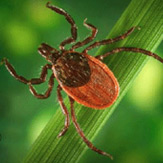Time is Ticking as Lyme Disease Season Gets Underway
Written by admin, July 8, 2013
July 8, 2013 – Public Health Reminds Residents to be Tick Smart
As the summer months arrive, they not only bring sunshine and great weather but also the unfortunate risk of Lyme disease courtesy of blacklegged ticks. The Peterborough Public Health is reminding residents to be on the lookout for the small creature and to know what to do in case an encounter occurs.
“Lyme disease is a potentially serious illness that is caused by bacteria and is spread to humans through the bite of an infected blacklegged tick,” says Laura MacMillan-Jones, Vector Borne Disease Program. “As the disease becomes a growing health threat across Ontario, residents are reminded to be aware and take precautions.”
The ticks are small in size (1-5 mm when unfed), red-brown in colour and do not fly. They are usually found low to the ground or settled on tall grasses and bushes where they will wait until they can attach themselves to a person or animal passing by. An infected tick acquires Lyme disease after feeding on the blood of an infected small animal and can spread the bacterium to humans if it remains attached for more than 24 hours. Lyme disease is not contagious, therefore cannot be spread through human-to-human or pet-to-human contact.
“If you do locate a tick on your body, use tweezers to grasp the tick as close to your skin as possible and pull the tick straight out. Full instructions are available on our website at www.peterboroughpublichealth.ca,” advises Laura. “Save the tick in a zipper-closed bag and take it to Peterborough Public Health. The tick will then be sent away to the Ontario Public Health Laboratory for identification.”
Though ticks can be found anywhere due to attaching themselves to migratory birds, there are several locations in Ontario with well established blacklegged tick populations:
- Long Point Provincial Park
- Prince Edward Point National Wildlife Area
- Turkey Point Provincial Park
- Rondeau Provincial Park
- Point Pelee National Park
- St. Lawrence Islands National Park
- Wainfleet Bog Conservation Area
For the best protection against Lyme disease:
- Wear light-coloured clothing as it makes ticks easier to spot;
- Wear closed footwear with socks, long sleeved shirts and pants, and tuck your pants into your socks;
- Use a bug repellent that contains DEET and follow the manufacturer’s directions;
- Search your body, especially the scalp, groin, back of knees and armpits for ticks at least once a day if you are in an area where you might get bitten by ticks
- Check your pets for ticks as they can accidently bring them inside;
- Keep your lawn neatly mowed and remove leaf debris on a regular basis; and
- Line the edge of your property with wood chips or gravel if a large amount of vegetation surrounds your yard.
Redness or a bulls eye shaped skin rash at the site of the bite is a common sign of the disease. If you have travelled to an area where ticks are common and have any symptoms that include fever, headache, muscle pain, joint pain or fatigue let your health care provider know immediately as these are signs for Lyme disease.
For more information please call Public Health at 705-743-1000, visit www.peterboroughpublichealth.ca or www.cdc.gov/lyme.
-30-
For further information, please contact:
Laura MacMillan-Jones or Dylan Mahoney
Vector Borne Disease Prevention Program
Peterborough Public Health
(705) 743-1000, ext. 339 or ext. 340

